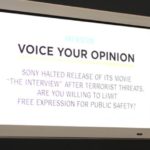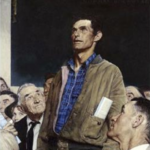Students explore the scope and limitations of the First Amendment provision that protects freedom of the press. The lesson poses a hypothetical scenario involving student journalists handling private information. After a brief class discussion, students investigate the history, various interpretations, and modern relevance of First Amendment freedom of the press protections in the Interactive Constitution. The lesson builds on the freedom of speech lesson plan by asking students to compare and contrast the freedoms of speech and press through discussion questions including: How are speech and press related? and How are speech and press key to democratic functions?
Freedom of Assembly: The Right to Protest
This lesson will focus on freedom of assembly, as found in the First Amendment. Students will consider the importance of the right to assemble and protest by analyzing cases where First Amendment rights were in question. Using the case National Socialist Party of America v. Village of Skokie, students will consider if the government is ever allowed to control the ability to express ideas in public because viewpoints are controversial, offensive, or painful. Students will use primary sources and Supreme Court cases to consider whether the courts made the correct decision in the National Socialist Party v. Skokie case. Students will be able to form an opinion on the essential question: Is the government ever justified to restrict the freedom to assemble?
You Can’t Say That: In My Opinion

Apply what you learned about constitutional exceptions to the First Amendment by studying a modern situations. Be sure to summarize the facts of the situation and then present your opinion about whether the actions of the individual in the scenario were protected by the First Amendment. If you disagree with the court, school or law enforcement’s decision, be sure to explain why you disagree.
Norman Rockwell, Freedom of Speech—Know It When You See It
Freedom Summer 1964
Freedom Summer is a digital learning tool (available on the web or as an app) for teachers and students that explores key events surrounding this time in America’s history and the impact of the civil rights movement on civil rights legislation. Players predict the outcomes of civil and congressional actions and discover how the events are intertwined. Students have the opportunity to view informative intro and outro videos and analyze 20 primary sources depicting images of civil rights events. Analysis of a variety of primary sources and supplemental information leads students to identify varying perspectives and potential outcomes. Freedom Summer is formatted for all types of computers and mobile devices, including Chromebooks, and can be found on the website or in any app store for download.
Statue of Freedom and Philip Reid Primary Source Lesson
This primary source exploration focuses on the statue atop the Dome of the U.S. Capitol. More than 19 feet tall and cast in bronze, its name is Freedom. American artist Thomas Crawford sculpted Freedom from plaster at his studio in Rome, Italy. Crawford created three designs.
The Sedition Act: Certain Crimes Against the United States

The Sedition Act of 1798 passed during John Adam’s administration by the Federalist Party touched off a lively debate about the right of free speech. It also presented an early test case to the citizens and government of the United States. In times of war or imminent danger, how do you balance the need for security with the rights of individuals? How can partisan politics affect the process of shaping security policies?
The Press and the Civil Rights Movement Video Lesson

Civil rights leaders effectively used the First Amendment and the press to expose the injustices of racial segregation. Reporters who covered the civil rights struggle give up close and personal accounts. Learn more about the First Amendment’s power to bring about profound social change and the role and challenges a free press embraces when tackling controversial issues.
Freedom of Assembly: National Socialist Party v. Skokie
This film explores the First Amendment right of the “people peaceably to assemble” through the lens of the U.S. Supreme Court case National Socialist Party of America v. Village of Skokie. The legal fight between neo-Nazis and Holocaust survivors over a planned march in a predominantly Jewish community led to a ruling that said the neo-Nazis could not be banned from marching peacefully because of the content of their message.
‘Speech Is More Than Speaking’
“Speech Is More Than Speaking” is a We The Future Contest winner for Best Short Film by Jacob VanDerwerken. What is Freedom of Speech if you cannot speak? Using American Sign Language, Jacob VanDerwerken explains the First Amendment’s Freedom of Speech is not just verbal language. This video is a discussion starter for students and adults.
